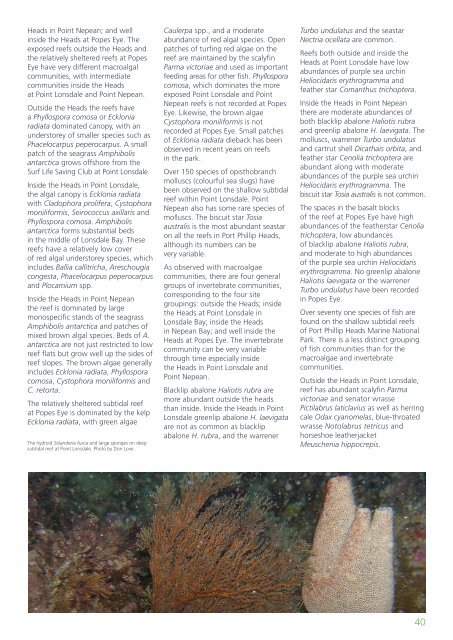Marine Natural Values Study Summary - Parks Victoria
Marine Natural Values Study Summary - Parks Victoria
Marine Natural Values Study Summary - Parks Victoria
You also want an ePaper? Increase the reach of your titles
YUMPU automatically turns print PDFs into web optimized ePapers that Google loves.
Heads in Point Nepean; and wellinside the Heads at Popes Eye. Theexposed reefs outside the Heads andthe relatively sheltered reefs at PopesEye have very different macroalgalcommunities, with intermediatecommunities inside the Headsat Point Lonsdale and Point Nepean.Outside the Heads the reefs havea Phyllospora comosa or Eckloniaradiata dominated canopy, with anunderstorey of smaller species such asPhacelocarpus peperocarpus. A smallpatch of the seagrass Amphibolisantarctica grows offshore from theSurf Life Saving Club at Point Lonsdale.Inside the Heads in Point Lonsdale,the algal canopy is Ecklonia radiatawith Cladophora prolifera, Cystophoramoniliformis, Seirococcus axillaris andPhyllospora comosa. Amphibolisantarctica forms substantial bedsin the middle of Lonsdale Bay. Thesereefs have a relatively low coverof red algal understorey species, whichincludes Ballia callitricha, Areschougiacongesta, Phacelocarpus peperocarpusand Plocamium spp.Inside the Heads in Point Nepeanthe reef is dominated by largemonospecific stands of the seagrassAmphibolis antarctica and patches ofmixed brown algal species. Beds of A.antarctica are not just restricted to lowreef flats but grow well up the sides ofreef slopes. The brown algae generallyincludes Ecklonia radiata, Phyllosporacomosa, Cystophora moniliformis andC. retorta.The relatively sheltered subtidal reefat Popes Eye is dominated by the kelpEcklonia radiata, with green algaeThe hydroid Solanderia fusca and large sponges on deepsubtidal reef at Point Lonsdale. Photo by Don Love.Caulerpa spp., and a moderateabundance of red algal species. Openpatches of turfing red algae on thereef are maintained by the scalyfinParma victoriae and used as importantfeeding areas for other fish. Phyllosporacomosa, which dominates the moreexposed Point Lonsdale and PointNepean reefs is not recorded at PopesEye. Likewise, the brown algaeCystophora moniliformis is notrecorded at Popes Eye. Small patchesof Ecklonia radiata dieback has beenobserved in recent years on reefsin the park.Over 150 species of opisthobranchmolluscs (colourful sea slugs) havebeen observed on the shallow subtidalreef within Point Lonsdale. PointNepean also has some rare species ofmolluscs. The biscuit star Tosiaaustralis is the most abundant seastaron all the reefs in Port Phillip Heads,although its numbers can bevery variable.As observed with macroalgaecommunities, there are four generalgroups of invertebrate communities,corresponding to the four sitegroupings: outside the Heads; insidethe Heads at Point Lonsdale inLonsdale Bay; inside the Headsin Nepean Bay; and well inside theHeads at Popes Eye. The invertebratecommunity can be very variablethrough time especially insidethe Heads in Point Lonsdale andPoint Nepean.Blacklip abalone Haliotis rubra aremore abundant outside the headsthan inside. Inside the Heads in PointLonsdale greenlip abalone H. laevigataare not as common as blacklipabalone H. rubra, and the warrenerTurbo undulatus and the seastarNectria ocellata are common.Reefs both outside and inside theHeads at Point Lonsdale have lowabundances of purple sea urchinHeliocidaris erythrogramma andfeather star Comanthus trichoptera.Inside the Heads in Point Nepeanthere are moderate abundances ofboth blacklip abalone Haliotis rubraand greenlip abalone H. laevigata. Themolluscs, warrener Turbo undulatusand cartrut shell Dicathais orbita, andfeather star Cenolia trichoptera areabundant along with moderateabundances of the purple sea urchinHeliocidaris erythrogramma. Thebiscuit star Tosia australis is not common.The spaces in the basalt blocksof the reef at Popes Eye have highabundances of the featherstar Cenoliatrichoptera, low abundancesof blacklip abalone Haliotis rubra,and moderate to high abundancesof the purple sea urchin Heliocidariserythrogramma. No greenlip abaloneHaliotis laevigata or the warrenerTurbo undulatus have been recordedin Popes Eye.Over seventy one species of fish arefound on the shallow subtidal reefsof Port Phillip Heads <strong>Marine</strong> NationalPark. There is a less distinct groupingof fish communities than for themacroalgae and invertebratecommunities.Outside the Heads in Point Lonsdale,reef has abundant scalyfin Parmavictoriae and senator wrassePictilabrus laticlavius as well as herringcale Odax cyanomelas, blue-throatedwrasse Notolabrus tetricus andhorseshoe leatherjacketMeuschenia hippocrepis.40
















